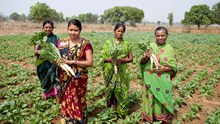
Strawberry guava (Psidium cattleyanum), also known as cattley guava, cherry guava, or lemon guava, is a small, evergreen tropical fruit tree native to southeastern Brazil and parts of Uruguay. Despite being lesser-known than the common guava (Psidium guajava), strawberry guava is gaining attention worldwide for its delectable fruit, low-maintenance cultivation, and potential as a niche market crop. With its vibrant red or yellow fruits, sweet-tart pulp, and rich aroma, this tree not only beautifies gardens but also offers a nutritional punch.
However, like many exotic species, its adaptability can become a double-edged sword, it has turned invasive in some regions. Still, when cultivated responsibly, strawberry guava presents exciting opportunities for small farmers, urban gardeners, and agripreneurs alike.
Botanical Profile and Characteristics
Strawberry guava is a hardy, multi-stemmed shrub or small tree that typically grows between 2 to 6 meters tall. It has smooth, reddish-brown bark, glossy dark green leaves, and attractive white flowers that bloom throughout the year in suitable climates. These flowers are pollinated primarily by bees and open in the early morning, lasting only a day. The fruits, which resemble small plums or large cherries, are round and measure about 2–4 cm in diameter.
They are usually red or yellow when ripe, with a thin skin, soft white or pinkish pulp, and numerous tiny seeds. The flavor is sweet with a slightly tangy note, often compared to strawberries, passionfruit, and guava all at once. Nutritionally, the fruit is rich in vitamin C, dietary fiber, and antioxidants, making it an appealing choice for health-conscious consumers.
Growing Conditions and Site Selection
Strawberry guava is incredibly versatile and can adapt to a wide range of environmental conditions. It thrives in tropical to subtropical climates and is best suited for areas where temperatures do not drop below -3 to -5°C. It prefers full sun but tolerates partial shade. In terms of soil, it grows well in sandy loam, clay, or even slightly rocky soils, as long as there is good drainage.
The ideal soil pH ranges from 5.0 to 7.5. Strawberry guava has moderate water needs and is drought-tolerant once established, but it benefits from supplemental irrigation during flowering and fruiting phases. Mulching around the base can help retain moisture, regulate temperature, and suppress weeds.
Propagation Techniques
Propagation can be done through seeds, but this method is unpredictable in terms of fruit quality. Seeds germinate within 3 to 8 weeks, and seed-grown trees usually take 2–3 years to bear fruit. For more consistent results, vegetative propagation is preferred. Softwood or semi-hardwood cuttings treated with rooting hormone can be rooted under high humidity conditions.
Air layering and grafting onto compatible rootstocks are also effective, especially for retaining desired traits such as fruit size, sweetness, or disease resistance. Once propagated, the plants are relatively fast-growing and require minimal inputs.
Crop Management and Maintenance
Strawberry guava is generally low-maintenance. Once established, it does not require intensive care. However, some pruning is recommended to shape the tree and improve airflow, which helps prevent fungal issues. Pruning also makes harvesting easier and encourages better fruiting. The plant is fairly pest-resistant, although fruit flies (especially in tropical regions), scale insects, and birds can be a concern.
Preventive measures like bagging fruits, using organic sprays, or setting up traps can help. Fertilization is minimal; applying compost or a balanced organic fertilizer twice a year before flowering and during fruit set is often enough. The tree can also serve as a hedge, windbreak, or ornamental plant due to its dense foliage and attractive form.
Harvesting and Yield
The tree typically begins fruiting 2–3 years after planting, although grafted or cutting-grown plants may fruit sooner. The fruiting season depends on the climate but usually occurs from late summer to early winter. Ripe fruits are best harvested by hand every few days, as they tend to drop once mature.
A mature tree can yield up to 30–40 kg of fruit per year under ideal conditions. Due to its thin skin and soft pulp, the fruit is highly perishable and should be consumed, processed, or refrigerated within a few days of harvest. Cold storage can extend shelf life by up to 1–2 weeks, but the fruit is most flavorful when fresh.
Culinary and Medicinal Uses
Strawberry guava’s culinary versatility makes it a favorite in homemade jams, jellies, fruit juices, syrups, desserts, and even fermented beverages like wines and ciders. The seeds, although edible, are typically blended or strained out during processing. The fruit’s sweet-tart profile pairs well with both sweet and savory dishes. In traditional medicine, various parts of the plant including the leaves and bark have been used to treat ailments such as diarrhea, sore throat, and gastrointestinal disorders. Scientific studies have confirmed its antioxidant, anti-inflammatory, and antimicrobial properties, further boosting its appeal in the natural health sector.
Market Potential and Economic Opportunities
Despite its relatively niche status, strawberry guava holds growing market potential. With rising demand for exotic fruits, health foods, and natural ingredients, there is a budding market for both fresh fruit and processed products. Farmers’ markets, specialty grocery stores, and farm-to-table outlets can serve as ideal entry points. Its appeal to home gardeners and permaculturists is another opportunity, especially in regions seeking low-input fruit crops for edible landscapes.
Value-added products like guava jam, syrup, candies, or dried guava slices can be developed by small food entrepreneurs or cottage industries, allowing for longer shelf life and better returns. Additionally, organic cultivation practices can tap into premium markets that value clean labels and sustainable sourcing.
Ecological Considerations and Management
While strawberry guava is beneficial in controlled cultivation, it poses ecological challenges in some countries. It has naturalized aggressively in places like Hawaii, Mauritius, and parts of India, where it displaces native vegetation and alters habitats. Its ability to reproduce through seeds (often dispersed by birds and animals) and root suckers makes it a difficult invader to contain.
To mitigate these risks, it is crucial to manage cultivation responsibly. This includes planting in contained areas, harvesting all fruits to prevent seed dispersal, pruning regularly, and avoiding its use near natural forests or conservation zones. In sensitive ecosystems, strawberry guava should be replaced with native or non-invasive alternatives.
Strawberry guava is a tropical gem that brings together beauty, flavor, and sustainability. Its ease of cultivation, nutritional benefits, and versatility in culinary use make it an ideal candidate for backyard gardens, small farms, and specialty fruit markets. While its invasive nature must be managed carefully, especially in biodiversity-rich regions, responsible cultivation can turn it into a profitable and eco-friendly crop. For those seeking to diversify their fruit production or tap into the growing demand for local, organic, and nutritious food, strawberry guava offers a compelling choice. With the right strategies in place, ranging from propagation to marketing, this humble fruit can become a symbol of sustainable abundance.
















